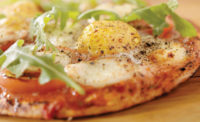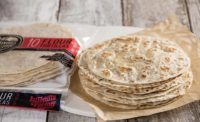
By Dan Malovany
After the recession hit some 18 months ago, Caribbean Food Delights found itself in the zone.
As consumers dined out less, ate at home more often and searched for new ways to stretch their budgets, the Tappan, N.Y., producer of Jamaican patties discovered that it already had what it considered the perfect meal solution.
Its 5-oz. beef, chicken, seafood and vegetarian Jamaican patties not only are hearty enough for a meal, they also are convenient, handheld items that are on trend for consumers who are on the go.
Moreover, when sold in the economical 10-packs, the value-added turnovers are perceived by both consumers and retailers to be the right price at the right time, says Tim Conway, director of sales.
“If you can get a product out there for a dollar a meal, that’s where [retailers] see the market in the near term,” he says. “They’re seeing real value meals. We happen to fit in that category. We’re 96 cents a patty. We’re one quarter of a pound. We’re like the quarter-pound burger for 99 cents or less.”
Hindsight is always 20/20, but the company’s $17 million expansion that was completed two years ago couldn’t have happened at a better time. It added a state-of-the-art line that doubled production capacity and tripled its holding freezer space from 10 to 40 trailer truckloads for much-needed inventory.
“Previously, we held back on [seeking] new customers until we were able to increase our production capacity, ensuring our proper inventory for all of our existing customers,” Conway says.
With the recent expansion, it’s no problem, mon. The growing pains are over. In fact, production capacity at its manufacturing facility now hovers around 50%, which has allowed Conway and his team to ramp up sales and pursue more avenues of growth.
At the same time, the company made several changes that improved the facility’s overall efficiency and lowered overhead, which enables the company to be one of the category’s lowest-cost producers.
Meeting Pent-up Demand
In addition to meeting the pent-up demand for its core products, the new versatile production line can produce yet-to-be-announced products that will help Caribbean Food Delights enter new product categories early next year.
It also helped improve product quality and consistency, notes Vincent HoSang, president and CEO. Instead of producing patties made with sheeted dough, the new line creates a laminated sheet that produces a flakier and more flavorful crust than in the past.
That’s especially important, he adds, because the company has been responding to those dominant consumer trends toward healthier foods during the last eight years by reformulating its products to add whole grains and a greater amount of fiber while removing trans fats and lowering the amount of saturated fats per serving.
“The challenge was removing the trans fat without changing the taste or texture and getting the same quality that we had before,” he says.
In the facility, which is inspected daily by the U.S. Department of Agriculture prior to production, 70 employees work five to six days a week on a single daytime shift.
In addition to a Hazardous Analysis Critical Control Points (HACCP) regimen, the plant follows detailed sanitation procedures for the meat and dairy products, as well as ready-to-eat items that require strict testing for pathogens to make sure the equipment is clean, says Raquel Pascual, senior food technologist. All records, she adds, are routinely reviewed by the facility’s USDA inspector.
“When we wash down our equipment, we make sure that we take it step by step from the start with disassembly to wash down to sanitizing and to reassembly,” Pascual says.
Likewise, plant personnel inspects and documents everything from receiving ingredients to processing and packaging and also collects and sends out samples of finished product prior to releasing inventory for distribution. The company, Pascual adds, is currently in the process of getting its safe quality food (SQF) certification under the Global Food Safety Initiative.
Overall, the facility houses three lines. The new line produces about 40,000 pieces an hour, or about the same volume as the two older lines. Flour is stored in two, 70,000-lb. silos. The company’s original 10-trailerload freezer now only holds temperature-sensitive ingredients such as the two truckloads of meat that the operation uses weekly. The plant makes all fillings, which range from spicy beef and curry chicken to beef and cheese and spinach and cheese, from scratch and then fully cooks them in separate rooms from the patty production areas.
On the new line, a 1,300-lb. horizontal mixer creates the dough, which is divided into 300-lb. batches that are elevated and dumped into the hopper. After chunking the dough, the approximate 10-lb. slabs are conveyed to the first of five stations that gently sheet the dough. After laminating and folding the dough to create a 16-layer sheet, a series of stations eventually reduce it from 1.5 in. to 0.6 mm. thick. In all, the line has three gauging stations, one cross roller to stretch out the dough and one multi-roller that provides stress-free reduction.
Additionally, the systems are outfitted with PLC controls and red electric lasers that trace the ragged edges of the dough sheet to guide an adjustable conveyor that zigzags left and right to make sure the sheet is centered prior to entering the critical cutting stage.
Initially, the line used a four-lane stamper to cut the dough prior to filling and folding into patties. To reduce the number of rejections, that system was replaced with a rotary cutter that now seamlessly cuts the dough strips into 6-in. rectangles that are folded into unbaked patties.
Next, by switching out mobile conveyors, the unbaked patties can be diverted directly to the -40˚F spiral blast freezer after which they pass through metal detection and are bulkpacked. Or, the pieces head straight to a reciprocal conveyor and oven loader that automatically places 34 pieces across the 10-ft. by 100-ft. tunnel oven.
Following a 16-minute baking period, the patties travel to a spiral cooler set at 38˚F to lower the internal temperature of the freshly baked products from 200˚F to 100˚F in 20 minutes. In addition to gently lowering the products’ temperature prior to entering the blast freezer, the cooling stage also helps save energy by allowing the patties to freeze more quickly.
After freezing, the fully baked patties travel through a three-in-one detection device that X-rays, check weighs and provides metal detection prior to packaging. The patties travel to bulk packaging, where they’re placed 50 into a case for foodservice accounts, which include schools, restaurants, hotels, the military and even prisons.
For retail customers, the patties are aligned and indexed prior to horizontal form/fill/sealing before being automatically cartoned in convenient two-packs or the family-size 10-packs.
Investing in New Technology
With its capital investments, Caribbean Food Delights constantly searches for practical ways to be more efficient.
For example, its new line uses mechanical blast freezers instead of an older nitrogen one. That’s because it costs only 1 cent to freeze a patty using the mechanical freezer where it cost 8 cents a product with the nitrogen-filled one, Vincent explains. The company doesn’t have to worry about replacing nitrogen that evaporates into the atmosphere over time.
In addition, Caribbean Food Delights continues to streamline its packaging area with automatic cartoners and faster wrapping systems. Although the company is willing to invest in the latest technology, it hasn’t had success with its robotic pick-and-place packaging system that, unfortunately, hasn’t worked since day one. Vincent is hoping that the system’s supplier eventually will spend time to figure out how to get the system to work.
With the ongoing concerns with the environment, Caribbean Food Delights implemented many measures in its efforts to go green.
To mention a few, the company is purchasing a new packaging line that uses less cardboard and installed hand dryers and extra insulated doors in refrigerated areas such as the loading dock to maintain temperature and quality of products. Moreover, it is going paperless in the office by using electronic data interchange (EDI) and encouraging its consumers to recycle its packaging.
Currently, the company’s three-year plan includes doubling warehouse capacity and adding yet another production line to meet projected sales. Vincent is always looking for different ways to spread the warmth of Caribbean-inspired foods and is toying with the possibility of going beyond the freezer case in a few years.
At this time, he insists most of those plans remain a pipedream.
Then again, despite its size, don’t underestimate the potential of Caribbean Food Delights. Pipedreams are what have made this company successful in the first place.


